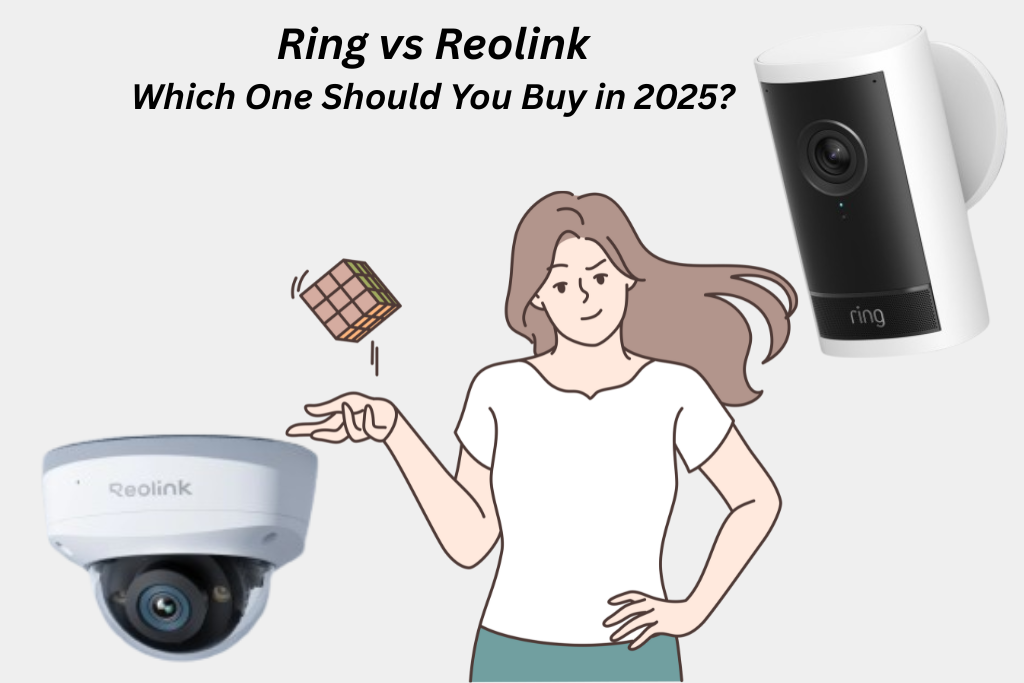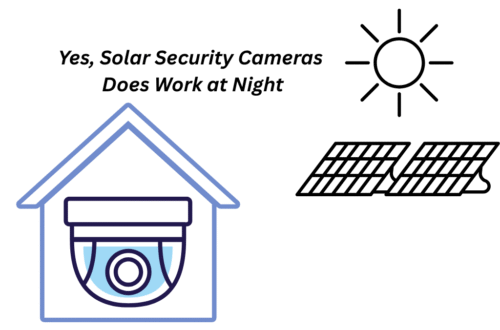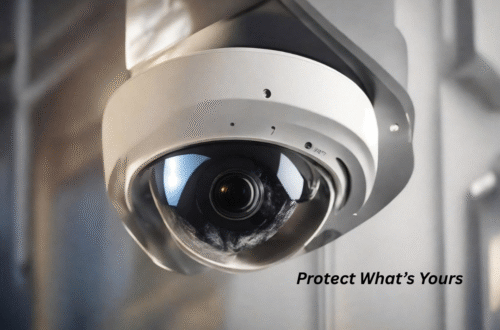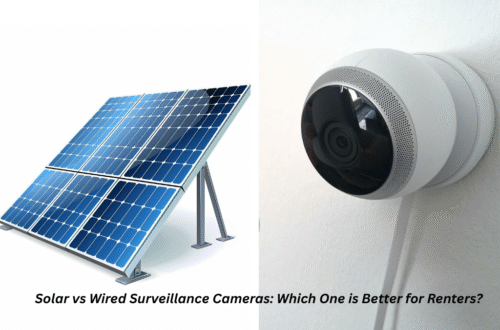
Ring vs Reolink: Which One Should You Buy in 2025?
Let’s explore Ring vs Reolink cameras in different features. We will also explain why experts prefer Reolink for affordability and Ring for better quality images and videos.
Ring
Ring gained fame for its video doorbells and outdoor cameras. It was acquired by Amazon. Its products are designed to integrate tightly with Alexa and the Amazon ecosystem.Ring’s setup is easy and is simple to use. It offers professional monitoring services. Ring’s drawback is reliance on cloud storage and subscriptions. The local storage is restricted unless you purchase additional hardware like Ring Alarm Pro. Ring offers a broad catalog. This includes affordable indoor cams to advanced PoE kits and off-grid LTE models.
Reolink
Reolink was founded in 2009. It became well-known for its Argus line of wireless cameras. Its main strengths are
- Hybrid storage (local + cloud)
- A wide range of connectivity (Wi-Fi, PoE, LTE)
- Features that often unlocked without subscription fees.
Its newer AI detection features are solid. But they don’t always match the top-tier smart cams in precision. Also, Reolink’s mobile app can be somewhat complex.
Ring vs. Reolink: A Fair Comparison?
When comparing with Ring, Reolink offers better flexibility as it does not require a subscription to access video storage. On the other hand, Ring cameras integrate better with smart home ecosystems. It also offers stronger cloud encryption. If you prioritize smart integration and ease of use, Ring wins. If you prefer local storage, privacy control, and cost savings, Reolink is more appealing.
The criticism against Reolink isn’t baseless, it’s about expectations. Reolink cameras are consumer-grade and designed for casual use. They cannot provide a forensic-level surveillance. They deliver bright, detailed images for daytime monitoring but fail to capture clear motion at night. This feature is an essential factor in real-world security situations.
Quick Comparison of Ring vs. Reolink
The two brands differ in features and performance. Deciding between them is tricky. Yet here is a quick comparison to help you get the one that suits your needs.
| Feature | Reolink | Ring |
| Video Quality | Up to 4K. Many models offer 2K as standard | Mostly 1080p HD |
| Local Storage | microSD / NVR | Not built-in (only via Ring Alarm Pro) |
| Cloud Storage | Optional; free tier | Required for most features |
| Smart Detection | Included (person/vehicle) | Only with subscription |
| Alexa Integration | Yes | Best compatibility |
| Google Assistant | Yes | Limited support |
| Subscription Required? | No (for core features) | Yes (for full features) |
| Power Options | Battery, solar, wired, PoE, LTE | Battery, solar, wired |
| Professional Monitoring | DIY only | via Ring Protect Pro or Virtual Guard |
| App/UI | Powerful but less polished | Streamlined, beginner-friendly |
| Best For | DIYers, users avoiding fees | Smart home users, Alexa ecosystem |
| Entry Prices | US$ 70 | US$ 60 |
Video Quality and Low-Light Performance
You can check how each brand is doing in these terms.
Daytime Clarity
Ring models record in 1080p which is sufficient for typical home monitoring. While Reolink Argus 3 pro offers more details in daytime. You can even see cracks on the pavement or license plate markings with calrity.
Night Vision
Ring uses infrared night vision in most of models. It also incorporate floodlight or color night vision. However, these bright lights can be overwhelming or distracting. Reolink often balances better. Many of its models offer color night vision with more subtle lightning. It also offers capturing ambient color even in low light. Especially in absolute darkness, the Rring’s infrared tends to hold steadier. On the contrary, Reolink generally delivers more natural and usable night images.
Motion Detection and Alerts
Ring has evolved from basic motion alerts to more intelligent detection. Most of these benefits come with subscription plan. Otherwise the alerts are basic. Reolink’s newer cameras such as Argus 3 Pro, E1 Outdoor, RLC series include onboard person and vehicle detection by default. You dont need subscription. You can also draw custom motion zones. The timeline in the Reolink app highlights human vs general motion, making it faster to review events.
Storage Options
Ring offers cloud-first storage. It does not include microSD slots in most cameras. You must use Ring Protect to store view or download video footage. Their basic plan is $3.99/month per camera.
Reolink offers hybrid and local storage. It allows local recording to microSD, NVR, or FTP. you don’t need to pay extras. Its cloud plans are optional. The pricing starts around US$3.49/month for 30 GB for up to 5 cameras. Some cameras even include limited free cloud storage for 7 days.
Smart Home Integration and Voice Control
Ring excels in Alexa integration. You can ask Echo Show to display your camera feed or record video. Ring’s Google Assistant support is more limited; e.g., some features can’t be accessed from Nest Hub.
Reolink supports both Alexa and Google Assistant for basic commands like showing live feed. But compatibility is selective. Not all of its models work. In some models, advanced integrations like IFTTT are not officially supported.
App Experience
The Ring app is smooth and beginner-friendl. Its interface and video playback are easily manageable. By contrast, the Reolink app is feature-rich but more complex. But many features are nested and take effort to discover. On slower networks or with large memory cards, timelines can take longer to load. If you want simplicity, Ring wins. If you want advanced control, Reolink offers more depth.
Power Options
Ring supports wired, battery, and solar power. It does not support PoE or LTE. Its battery life is usually of 2-3 months.Reolink is more flexible. Depending on the model, you can use battery, solar, wired, PoE, or LTE (for remote locations). Some battery models can continuously run using solar panels.
Setup and Ease of Use
Ring’s setup is user friendly. For instance, you just have to
- Scan a QR code
- Connect to Wi-Fi
- Follow in-app instructions
- Mount it and you are done.
Reolink setup gives more options, which can be intimidating for non-technical users. You may need to
- Format memory cards
- Configure IP addresses
- Install SIM cards or wire networking cables
- Once configured, though, the customization is powerful.
If you want plug-and-play simplicity, Ring is better. If you want flexibility and professional options, Reolink is stronger.
Why Reolink is Not Prefferd by Experts?
Reolink cameras are well-known for their affordability and ease of setup. However, they have a controversial reputation too. Despite its effective features, the home security enthusiast and professional security forums advise against choosing Reonlink. Let’s break down the real reasons experts are skeptical about Reolink and how it compares to Ring.
The Main Concern is Reolink’s Poor Nighttime Performance
The most common criticism of Reolink cameras is their inconsistent performance at night. Reolink produces bright and clear static images. However, moving the photos not only blurs but also creates a ghost-like effect. In low light, the pictures become partially invisible. The key flaw is that Reolink’s image processing algorithm prioritizes a bright and well-lit image.
Why This Happens
This happens due to firmware and sensor limitations. Reolink cameras use small sensors. These are around 1/3″ or 1/2.8″. The image processing algorithms optimize for brightness and not for accuracy.
Premium security camera brands allow users full manual control. Users can manage shutter speed, gain, and exposure. On the contrary, Reolink often overrides user settings. Instead, it prefers to maintain a bright picture. That’s why, when users attempt to increase shutter speed to reduce the motion blur, they can’t. The firmware automatically compensates motion blur by slowing it down or increasing gain. This again blurs or ghosts the image. This shows that Reolink prioritizes a pleasant image for marketing photos rather than forensic-level clarity.
Daytime vs. Nighttime and Static vs. Motion Issues
Reolink performs decently during the day and in a well-lit environment. The static objects also appear crisp and colorful. However, once the darkness or motion enters, the identification becomes unreliable. Even users state that Reolinks’ own promotional videos show this issue. The blurred images make it difficult for law enforcement to use the footage as evidence.
Camera Purpose Matters: Overview vs. Identification
We understand that no single camera can do everything well. For effective surveillance and professional use, there are multiple cameras with specific roles. For instance, overview cameras are good for general area coverage. Likewise, zoom-in cameras are best for facial or license plate identification. Users who expect one Reolink camera to capture both an entire driveway and a readable face at night will likely be disappointed. Reolink’s wide field of view sacrifices clarity for coverage.
AI Detection: Comparable, But Not Perfect
Reolink’s AI for human and vehicle detection performs better than its competitors. It can distinguish between motion types with reasonable accuracy. However, users still experience occasional false positives, especially with insects or snowflakes at night.
When Reolink Might Still Be Worth It
Despite its drawbacks, Reolink has its place in certain setups. If you
- Need budget-friendly cameras for general monitoring
- Don’t rely on footage for identification or evidence
- Want plug-and-play simplicity,
Then Reolink can be a reasonable option. Also, Reolink’s customer support receives generally positive feedback. One user reported that the company provided step-by-step firmware upgrade files for an older camera, which worked perfectly after updates.
Conclusion
Despite the fact that experts don’t prefer Reolink for forensic quality footage, we cannot deny its affordability and best quality daylight video. Since both brands are renowned for their performance you can choose what suits your budget and security needs.
FAQs
Who is Ring’s biggest competitor?
Google Nest and Arlo are Ring’s biggest competitors.
Is Reolink a Chinese company?
Yes, it is a Chinese company. Reolink was founded in Shenzhen in 2009.
Do burglars avoid Ring cameras?
While skilled criminals may not affraid of any hurdles, burglars in general avoid Ring cameras.
Is there anything better than Ring cameras?
Brands like Arlo and Vivint are better than Ring cameras.




